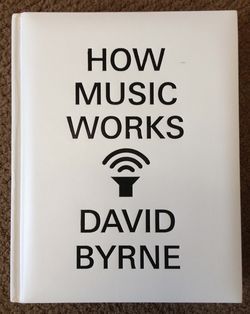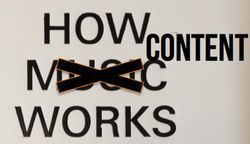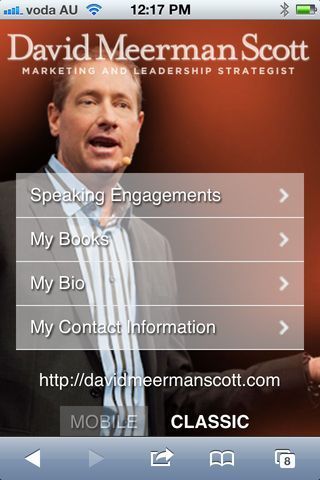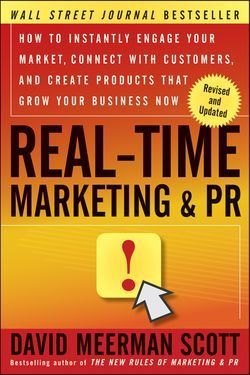David Meerman Scott's Blog, page 81
September 26, 2012
How Content Works
This is David Byrne week.
There is an important content marketing lesson to be learned from the Talking Heads front man and Rock and Roll Hall of Fame inductee, but first some background.
 On Sunday, I caught the sensational David Byrne and St. Vincent show at the Orpheum Theater with my friend, HubSpot CEO Brian Halligan. Regular readers know I'm a mega music geek and maintain a spreadsheet with, as of this writing, 518 bands I have seen in concert since I was 16. The David Byrne and St. Vincent show was top ten. Really. It was that good.
On Sunday, I caught the sensational David Byrne and St. Vincent show at the Orpheum Theater with my friend, HubSpot CEO Brian Halligan. Regular readers know I'm a mega music geek and maintain a spreadsheet with, as of this writing, 518 bands I have seen in concert since I was 16. The David Byrne and St. Vincent show was top ten. Really. It was that good.
Consulting my spreadsheet, I see the last time I saw Byrne live was when I caught the Talking Heads on August 19, 1983 at the old Forrest Hills Tennis Stadium in New York City. Here's the NYT review of that show.
How Music Works
 The other part of David Byrne week is his fabulous new book How Music Works. The book is Byrne's take on the industry he's succeeded in. He offers keen observations about the music industry, the art of making music, telling stories in the book using a combination of history, anthropology, and music theory. I love this book!
The other part of David Byrne week is his fabulous new book How Music Works. The book is Byrne's take on the industry he's succeeded in. He offers keen observations about the music industry, the art of making music, telling stories in the book using a combination of history, anthropology, and music theory. I love this book!
In particular, Byrne has a fascinating take on the development of music, which is quite different from what other music historians say. In a chapter titled "Creation in Reverse" he argues that music evolves to fill the space where it is performed.
For example, the Talking Heads evolved in the 1970s at New York punk club CBGB requiring volume to overcome the din. The sparse music that came out of the CBGB scene such as the Ramones and Television worked perfectly for that room.
Music that evolved in gothic cathedrals (lots of reverberation) has long notes with no key changes. Carnegie Hall and other similar rooms require texture. With discos, people made music to exploit the fantastic sound systems and people’s need to dance. Rock music played in hockey arenas (the worst acoustics on the planet) must be straightforward with medium tempos. You get the idea. The music that is successful works perfectly for each venue.
With personal sound systems (starting with the Walkman in the 1970s then evolving into MP3 players such as the iPod), all of a sudden you can hear every single detail. This allowed pop music to evolve from its early radio form.
Here is Byrne's 2010 TED Talk on this idea: How architecture helped music evolve.
How Content Works
 As I devoured How Music Works I was constantly thinking how Byrne's ideas apply to other forms of content. These ideas are very important for content marketers.
As I devoured How Music Works I was constantly thinking how Byrne's ideas apply to other forms of content. These ideas are very important for content marketers.
As I see it, success using the different forms of online content is evolutionary to the way the content is consumed. The best content evolves to fill the new media (such as blogs, YouTube videos, Tweets, photo sharing, and the like). Each new way to create content means a new form of content is best suited for the media.
This seemingly simple idea has wide ranging application for marketers and helps explain why some content succeeds and others fail in new environments.
Here are a few specifics:
Distribution: Prior to the Web, creators expected the production and distribution of content to be expensive. You had to print things on paper. You needed to buy film and develop images. You needed to pay to send your stuff in the mail or over the airwaves. With the Web, all of a sudden the cost of creation and distribution falls to zero. For that reason, the quantity of content exploded. People were much more tolerant of less than perfect content. The evolution meant that casual videos worked on YouTube and you didn't need a $50,000 production budget. Blogs without professional editors built a following. The content evolved to fill the medium.
Registration: With the sharing of long form content like white papers and ebooks, nearly all marketers started offering their stuff the same way they did offline – with a requirement that you have to register to get the document by filling out a form with your email address and other personal information. After all, marketers said, that's what we did offline. But doing that is like playing The Ramones in a gothic cathedral. The content doesn’t fit the venue. When Seth Godin and a few others pioneered the offering of valuable content like ebooks completely free with no registration, a new model that fits the environment of sharing on the web was born. It turns out people eagerly share free content driving the number of views. The content evolved to fill the medium.
Instant: When Google started indexing content for Google Search in real-time, it transformed how information is found. For example, this blog post was indexed by Google the second I posted it. Yet this profoundly important concept is widely misunderstood. Because search engines used to take months to index new content people didn’t have to be quick to post about breaking news. My ideas around Newsjacking were focused on how blog content is slowly evolving based on real-time indexing. Just like how music evolved with the Walkman, content is now evolving to fit with real-time indexing.
David Byrne's How Music Works is amazing. Read it. And as you do, substitute "content" for "music" and see where the ideas lead you. Share them here if you'd like.
Disclosure: How Music Works links to the Amazon Affiliate program.
September 24, 2012
How to make your site mobile friendly
Apple reported more than five million iPhone 5 units were sold in the first three days that it was offered for sale. And it's not just Apple products. Mobile is now the preferred way many people get online.
With the huge popularity of smartphones and around the world, it is now essential that all organizations have a mobile-friendly site to make it easy for people to find you.
Check out your own site
For a long time I did not have a mobile strategy. It was always "on my list" but never got to the top until one day I realized I was delivering a horrible mobile experience for my buyers when I went to my own site on my iPhone. That got me to act. (Have you seen your site on a mobile device?)
 So early this year, I worked with both Jim Stewart at Melbourne, Australia–based StewArt Media and Doug Eymer of Eymer Design to help me. Doug did the design work and Jim's team worked on the technology and all-important Search Engine Optimization components. Check out Jim's SEO blog and Doug’s Marketing and Design blog.
So early this year, I worked with both Jim Stewart at Melbourne, Australia–based StewArt Media and Doug Eymer of Eymer Design to help me. Doug did the design work and Jim's team worked on the technology and all-important Search Engine Optimization components. Check out Jim's SEO blog and Doug’s Marketing and Design blog.
Why a mobile strategy is important
Fun (and important) fact: The Google Mobile search engine indexes differently than the main Google search engine. You need to optimize for both.
If you actually sell a product, a mobile can be a great way to generate new revenue.
"For many businesses mobile is now a new channel and not merely an extension of the web experience," Jim told me. "In Australia over 25% of PayPal users have made a purchase using a smartphone. If you use Google AdWords you can now target mobile users directly and place a clickable phone number in the ad so they simply call through to your business, bypassing your website entirely. We had a Car Dealership client that used this method and had an amazing result."
Read Jim's 4 Crucial Questions to Get Your Business Mobile-Ready.
A few things you can do right now
1. Make sure your site is mobile compliant. You need the pages to load properly in mobile devices.
2. Create a mobile sitemap so the search engines can index your pages for mobile browsers.
3. Use few words and small graphics. People don't read much on mobiles and they want the data to come quickly.
The challenge is to understand this new landscape so you can get your business into the mix at that precise moment of decision. I chose to work with experts and it was the right decision for me.
Don't miss out on opportunities to sell to the many people now accessing their sites from wireless devices.
Disclosure: I have worked with both Doug and Jim on many projects and I pay them when they help me. I mention them in this post because I want to recognize their good work. I am not compensated in any way for doing so.
September 21, 2012
Twitter launches header photos. Time to add yours.
This week Twitter launched an important new feature: the ability to add a header photo to your profile.
As usual, HubSpot was on top of the news in real-time and quickly wrote this "how to" post: Twitter Rolls Out Cover Photos: How to Add Yours Today.
 I conferred with my go-to designer Doug Eymer on what I could do with mine and updated my @dmscott Twitter profile page in just a few minutes.
I conferred with my go-to designer Doug Eymer on what I could do with mine and updated my @dmscott Twitter profile page in just a few minutes.
Facebook has had a feature like this for some time, so the concept is not new. But I'm surprised at how few people use it.
A header photo is a great way to show your personal brand.
Don't try to sell
I suspect many sales & marketing types will add an advertising message to this real estate. I'd recommend resisting this tendency. Adding your messages or heavy-handed branding to the header, in my opinion, detracts. Sure, I could have used an image of, say, all my book covers for my cover. Instead I chose an image I really like of me speaking at the NAMM conference earlier this year shot by Jay Blakesberg earlier this year.
Your header photo will show up on your Twitter web page as well as on mobile devices. On my iPhone, it looks fantastic, greatly adding to my personal branding.
Time to add your header photo, don't you think?
If you're inclined, please leave a comment with a link to yours so we can see some examples.
September 19, 2012
Real-time Uber app is pure awesomeness
My friend Laura Fitton introduced me to Uber a few months ago and now I am a raving fan of the service.
 Uber is an iPhone app (it is also available on Android) that you use to book private driver service, typically in a Lincoln Town Car, in major cities. Currently the service is available in 15 cities including SF, NYC, Boston, Paris, and London.
Uber is an iPhone app (it is also available on Android) that you use to book private driver service, typically in a Lincoln Town Car, in major cities. Currently the service is available in 15 cities including SF, NYC, Boston, Paris, and London.
For a passenger, you use the app to see if cars are nearby. Then you tap a button to request a ride and immediately see how long it will take for your driver to reach you (all done in real-time with Geo-location). You get a message with your driver's name, mobile number, and car license plate number. And in just a few minutes your ride appears.
So on Tuesday the beauty of Uber was in full glory for me when I arrived at San Francisco airport for the Dreamforce event on Tuesday. 50,000 other people were also arriving for Dreamforce during these few days and the taxi line was one hour long (I asked the people at the head of the line). The photo above shows only about 20% of the line. It was probably 100 meters long.
So I popped up Uber and five minutes later I was seated in a comfortable black car being whisked in style to my hotel. Brilliant. The real-time aspects of the app for a passenger are amazing.
Uber pricing is between a regular taxi fare and the fare for a typical telephone booking of a private car service. I paid $65 for my SFO ride to the city.
If you want to try Uber, this link gets you a $10 credit on your first ride.
What about the drivers?
 This week I had lengthy discussions with three Uber drivers to find out their side.
This week I had lengthy discussions with three Uber drivers to find out their side.
The drivers are independent owner-operators who sometimes use old-style telephone broker services to book business as well. The drivers are also enthusiastic. I heard the following "I love Uber!" And: "I target $300 a day from Uber and almost always hit my goal." And: "I average 15 rides a day through Uber."
The app is just as slick for drivers. If they are free, they get a beep on their phone and can instantly see that a passenger is waiting for a ride. They can choose to accept of decline the ride. If they accept, the passenger's name and mobile number are made available and the passenger’s exact location displayed. When the ride starts, the driver hits the start button and then again at the destination, he terminates the ride on the app. Because the passenger’s credit card number is charged and the credit made to the driver’s Uber account, no cash changes hands and it is very quick. Both passenger and driver can rate one another on a 5-star scale much like eBay. Easy!
Disintermediation
Like many businesses before it, the market for private car services is being transformed by real-time mobile technology from Uber. Just like books (with instant Kindle downloads) and many other industries, real-time technology is disintermediating traditional businesses.
I can't gush enough about Uber. I just love the service.
Try Uber with this link and get a $10 credit on your first ride.
Disclosure: I too get a $10 credit for anyone who signs up with the link. But in no way did a write this post to get a few dollars. I want to share a great real-time service and provide you the benefit of the credit. But with your credit comes mine.
September 13, 2012
Entrenched music business hates free content (again) & blasts Amanda Palmer

In the past few hours, two friends – C.C. Chapman and Justin Cambria - who both know I have written and spoken about rocker Amanda Palmer alerted me to a dustup around how the rock star is putting together bands for her tour.
On her blog, Amanda writes WANTED: HORN-Y AND STRING-Y VOLUNTEERS FOR THE GRAND THEFT ORCHESTRA TOUR!!!!
Now there is an active discussion on Amanda's blog with nearly 200 comments as I write this, many negative. The people who are critical say that Amanda must pay her musicians and that it is not fair to ask people to play for free. Mainstream media has picked up on the story including this from the New York Times Rockers Playing for Beer: Fair Play? and from prefix Amanda Palmer 'Can't Afford' To Pay Her Backup Band.
New business models in the music business
I'm with Amanda on this one.
Because she specifically says "volunteers," it is perfectly clear what she is looking for. In other words, it is not a bait and switch of some kind. Importantly, this request was a post on her personal blog so she can tap her fan base – it wasn’t posted on a musicians' site or another outside forum.
Whenever new business models emerge, the people who work within the established system recoil in horror. That happened to me over the past decade as I talked up new ways to market products and services on the Web. Many traditional agency people hated the ideas and told me so, mocking that you can reach people on the Web for free.
The entrenched powers that be in the music business actively resist change. They shut down Napster. They sue kids who download music. To this day, many record labels forbid YouTube distribution of music which is crazy because having your song on YouTube is, as Bob Lefsetz says, "the new radio."
Amanda constantly pushes new models such as firing her label and self-funding her latest album via Kickstarter. She offers downloads of her new album Theatre is Evil on a pay what you want basis. Traditional record labels hate this stuff.
With change comes opportunity
Journalism is another example of new business models evolving where the entrenched fight change. I write for free for the Huffington Post. I do this because by posting on HuffPo, I can reach a new audience. Many old guard media folks hate this. They say journalists should be paid. They say I am not a valid writer because I have no formal training. Guilty. So don't read me on HuffPo then. You don't have to read this blog. I'm cool with that.
Here's another important point: As models change, new opportunities emerge. For example, I've talked about the tremendous opportunity that journalists have working for companies outside mainstream media. Professional journalists can apply their skills at organizations of all kinds to create content. Companies as diverse as as Eloqua, Boeing, Inova Health System , and HSBC have all hired full-time journalists. For a professional journalist, as one door closes a little another opens wide.
As music models change, musicians should look to the positive, not the negative. Isn't it cool that you can make a website, blog, or YouTube channel for free to promote your music? That opportunity didn't exist a few years ago.
Sure you're not getting paid for Amanda’s gig. But it is your choice to play or not. Should you be an up and coming player, you can have some fun, get a credit, score some stage photos, and publish a YouTube video of the whole thing. You can then spread these via social media to gain exposure. For free.
This is a controversial topic that’s playing out right now in real-time. What do you think?
September 12, 2012
Content curation: A poor substitute for original content
You may have noticed that content curation has grown very quickly as a way for people and organizations to publish on the Web.
Sure, there are some benefits to this effort. But as a strategy for generating attention for yourself or your business, content curation is nowhere near as powerful as generating original content.
Content curation
Unlike writing your own blog post or shooting your own video, content curation simply involves pointing to others' work.
Services like Scoop.it and Paper.li have sprung up to make it easy for anyone to publish an online magazine by linking to anything on the Web.
Yes, there is value in pointing to others work. But that is the point – it is other people's work, not your own.
Many organizations use guest writers to create content, which in my mind is another form of content curation. Nothing wrong with having a guest blog post now and then, but if you never showcase your own peoples' ideas, I think it is a mistake.
Original Content: The focus a successful marketing
The best way to generate attention is to create original web content including text based information (sites, blogs, a Twitter feed), video content, photographs, infographics, and the like.
You brand yourself as an organization worthy of doing business with. Done well, an added bonus is that the search engines rank the content highly and people are eager to share the content on their social networks.
And hey if you generate some interesting stuff, then the content curators will link to you!! Wouldn't you rather have the links come in?
September 4, 2012
How to create awesome web content and achieve top search engine rankings
 This blog post highlights a very successful marketer - Larry Waight of The Lodge at Chaa Creek, an eco-resort in Western Belize - who has achieved high search engine rankings for many important keywords. This content marketing effort generates a remarkable 80% of new business for the Lodge. This important case example is among the best I've seen if you want to learn how content drives business. This is brand journalism at its finest.
This blog post highlights a very successful marketer - Larry Waight of The Lodge at Chaa Creek, an eco-resort in Western Belize - who has achieved high search engine rankings for many important keywords. This content marketing effort generates a remarkable 80% of new business for the Lodge. This important case example is among the best I've seen if you want to learn how content drives business. This is brand journalism at its finest.
As anyone who has built a web site knows, there is much more to think about than just the content. Design, color, navigation, and appropriate technology are all important aspects of a good web site. Unfortunately, in many organizations these other concerns dominate. Why is that? I think it’s easier to focus on a site's design or technology than on its content.
One of my favorite examples of sites with poor content but big budget design and technology are the global hotel chains. Go to any hotel property from the majors: Hilton, Sheraton, Marriott, or any others from around the world. They all look the same! They have almost no original content about that property!
Yes, appearance and navigation are important. But the best sites focus primarily on content to pull together their various buyers, markets, media, and products in one comprehensive place where content is not only king, but president and Pope as well.
Content drives action
Contrast the vast majority of hotel sites with that of The Lodge at Chaa Creek. I had an opportunity to stay at Chaa Creek a few weeks ago and I interviewed Larry Waight about how he creates his awesome content.
Direct link to the video How to create awesome web content and achieve top search engine rankings on YouTube.
Larry researches what people are searching on such as Belize honeymoon and Belize all inclusive. He then created content on his site or Belize Travel Blog specifically for these phrases which are ranked highly in the search engines.
Solving buyers problem with content
Most interesting to me is how Larry creates content that is about Belize, not just about the hotel.
This is an essential element of Chaa Creek's marketing success. Search terms such as Belize winter solstice 2012 and bird watching in Belize drive people to the lodge who were searching on general travel information. Brilliant.
 On his Belize Travel Blog, Larry also writes not about the lodge itself but about Belize travel such as Ten reasons why Belize makes for Honeymoon Bliss.
On his Belize Travel Blog, Larry also writes not about the lodge itself but about Belize travel such as Ten reasons why Belize makes for Honeymoon Bliss.
Brand Journalism
One of my favorite examples of this technique of writing about the things people are interested in is how Larry has created a bunch of content about the local Mayan sites nearby the hotel such as Xunantunich Maya Temples. And, get this, he even writes about the Tikal Mayan site - which is in Guatemala – another country! - about two hours from Chaa Creek.
All this content drives people to the hotel site and blog through the search engines and many people will then choose to stay at The Lodge at Chaa Creek. Indeed, some 80% of new bookings to the Lodge are from this content marketing effort.
Note that the reason I went to Belize was because Larry reached out to me via Facebook. We talked about a visit that combines visiting Chaa Creek with a speaking gig for the Belize Tourism Industry Association in Belize City where I spoke to 300 marketers. It was Larry’s content marketing efforts that got me to Belize. Thanks Larry! I’m planning on returning with my family.
This is one of the best examples of content marketing I've seen. If you want to learn more about how Larry creates content, do take the time to watch the video.
August 27, 2012
Newsjacking a naked Prince Harry
Over the past week, I've noticed a bunch of people attempting to newsjack the stories of Prince Harry's Las Vegas romp. As you have likely heard many times by now, naked photos surfaced of the Prince cavorting with equally undressed women in a hotel suite.
While most newsjacking attempts went unnoticed, several were highly successful.
Newsjacking works when you have a tie to the story
The pattern is quite consistent – the more of a tie you have to the story, the better your success at newsjacking.
 The location of the Prince Harry photos was the luxurious Encore Wynn Hotel. The owner of the hotel, Steve Wynn publicly waived the tens of thousands of dollars hotel bill, which got the Wynn into, by Google News count, 3,657 stories. For example, this one from the UK’s Daily Mail Living like a king: Prince Harry's £30,000 hotel bill 'waived' by Vegas billionaire is essentially a huge, free advertisement for the luxury Encore Wynn Hotel complete with descriptions and photos of the property as well as the royal suite.
The location of the Prince Harry photos was the luxurious Encore Wynn Hotel. The owner of the hotel, Steve Wynn publicly waived the tens of thousands of dollars hotel bill, which got the Wynn into, by Google News count, 3,657 stories. For example, this one from the UK’s Daily Mail Living like a king: Prince Harry's £30,000 hotel bill 'waived' by Vegas billionaire is essentially a huge, free advertisement for the luxury Encore Wynn Hotel complete with descriptions and photos of the property as well as the royal suite.
This is a perfect example of newsjacking success. For the price of waiving a few hotel nights, the Wynn gets mentioned in thousands of stories. This isn't the first time that the Wynn has newsjacked. Here's another example I wrote about a few years ago: Wynn Resorts real-time Paris Hilton PR triumph.
 Another example of success was the $10 million offer made to Prince Harry by Steven Hirsch, CEO of Vivid Entertainment, to appear in a porn film titled The Trouble with Harry. The offer was shared with TMZ who wrote about it in a story titled Prince Harry Offered $10 Million to Bone on Film. If you click over to the story, you can see the actual written offer document, which makes for some fun reading. This story appeared in 642 mainstream media stories according to Google News.
Another example of success was the $10 million offer made to Prince Harry by Steven Hirsch, CEO of Vivid Entertainment, to appear in a porn film titled The Trouble with Harry. The offer was shared with TMZ who wrote about it in a story titled Prince Harry Offered $10 Million to Bone on Film. If you click over to the story, you can see the actual written offer document, which makes for some fun reading. This story appeared in 642 mainstream media stories according to Google News.
Again, the Vivid Entertainment newsjack succeeded because the company produces pornographic films and Harry was caught in photos with his pants down. By sharing the actual offer with TMZ, the story was sure to be picked up in mainstream media.
Lessons from Prince Harry
The lesson learned here is if you want to newsjack successfully, you've got to have a legitimate tie to the story. If you do, and you put out there, journalists who are hungry for second paragraph content for their news reports may include you in their stories.
The other lesson, is you've got to be quick. Stories like this break in a matter of hours and if you dilly-dally, you won't be seen as reporters are writing their stories.
August 22, 2012
The real time business mindset
 It's been nearly two years since the original edition of Real-Time Marketing & PR was published and reached #2 on the Wall Street Journal bestseller list. Since then, I've published a new, revised paperback edition with some fresh stories of success.
It's been nearly two years since the original edition of Real-Time Marketing & PR was published and reached #2 on the Wall Street Journal bestseller list. Since then, I've published a new, revised paperback edition with some fresh stories of success.
I've delivered talks about real time marketing in more than a dozen countries (as I write this I am in Belize doing a session for the Belize Tourism Industry Association) as well as to many audiences in the U.S. People are intrigued by social media, but it's interesting to me that when I speak with executives around the world about social, many *still* push back and resist. They tell me about their kids' Facebook or talk about Twitter by saying what they had for lunch isn't important. They’ve already made up their minds that social is frivolous at best and a dangerous time-waster at worst.
Convincing the bosses
In order to scale social, I recommend that we not using the word "social" at all and instead substitute "real-time".
When I talk to the same executives about "real-time communications with customers" they lean forward and want to know more. These are the same people who dismiss Twitter.
I tell executives that an immensely powerful competitive advantage flows to organizations with people who understand the power of real-time information. What are people doing on your site right now? Has someone just praised you on Facebook? Panned you on Twitter? Published a how-to video about your product on YouTube?
Executives understand real-time and are eager to implement the ideas.
Conventional vs. Real-Time
The conventional business approach favors a campaign (note the war metaphor) that requires people to spend weeks or months planning to hit targets. Agencies must be consulted. Messaging strategies must be developed. Advertising space/time must be bought. Conference rooms and refreshments must be prepared for press conferences. Do you serve them sushi or sandwiches?
The real-time mind-set recognizes the importance of speed. It is an attitude to business (and to life) that emphasizes moving quickly when the time is right.
Developing a real-time mind-set is not an either/or proposition. I'm not saying you should abandon your current business-planning process. Nor do I advocate allowing your team to run off barking at every car that drives by. Focus and collaboration are essential.
Large Organizations Need to Work at It
The more people you have in an organization, the tougher it is to communicate in real time. In a command-and-control environment where no action can be taken without authority, without consultation, without due process, any individual who shows initiative can expect to be squashed.
The challenge is to develop a new balance that empowers employee initiative but offers real-time guidance when it's needed—like a hotline to higher authority.
In a real-time corporate culture everyone is recognized as a responsible adult.
If you're the leader, and you want to cultivate a real-time mind-set throughout your organization, tear down the command-and-control mentality. Recognize your employees as responsible adults. Empower them to take initiative.
August 18, 2012
Newsjacking controversy: MSNBC vs Ragan Communications
 Yesterday, Alan Stamm wrote a very critical article about Newsjacking on the Ragan Communications site called Meet the advocates of 'newsjacking': As if PR needs another self-inflicted injury, this movement is a stain on the industry.
Yesterday, Alan Stamm wrote a very critical article about Newsjacking on the Ragan Communications site called Meet the advocates of 'newsjacking': As if PR needs another self-inflicted injury, this movement is a stain on the industry.
Unfortunately, Stamm wrote his article without even bothering to read my book Newsjacking: How to Inject your Ideas into a Breaking News Story and Generate Tons of Media Coverage. Not reading the book didn't stop him from dismissing the ideas in it. I've got no problem with people criticizing my ideas, *if* they know what they are talking about. But to dismiss a book without reading it... ridiculous (and rude).
I commented on the post right away. It's ironic that the technique Stamm dislikes so much (following the news on Google and reacting quickly to provide information for reporters) is exactly how I found out about his article and why I commented immediately after it was posted. Lots of other people commented too.
Interestingly, in the same week that the Regan article came out, I was interviewed on MSNBC about Newsjacking. The reporter who interviewed me, JJ Ramberg from the MSNBC Your Business program, had nothing but praise for how newsjacking can benefit small businesses.
Direct link to MSNBC interview How to Generate Media Coverage on YouTube.
So here are the two varied takes on newsjacking:
Alan Stamm says in his Regan article: "Grabbing brazenly for online attention via topic du jour opportunism positions the perpetrator as a bottom-feeder. It's the opposite of "earned media," PR jargon for company profiles, quotes in news-reaction roundups and other coverage obtained the old-fashioned way."
However, JJ Ramberg said to me on air after I explained newsjacking: "I love this because it is much more likely that [a reporter] will call upon you if you can fit into a story they’re doing than when you’re trying to make news yourself."
Who is correct?
I've found that people like Stamm who don't understand newsjacking and who have negative views are reacting to the seemingly "bad" connotation based on similar words like "carjacking" and "hijacking" which decidedly are bad. But they don't bother to learn what newsjacking really is by reading my book or having me explain what the technique is.
What's changed recently to make newsjacking possible is that Google now indexes in real-time. That allows a timely blog post to be seen by journalists as they search for more information on a topic. Real-time is the key here. Yet nearly all PR people are in campaign mode rather than real-time mode, so those like us who understand newsjacking have an advantage.
What do you think?




